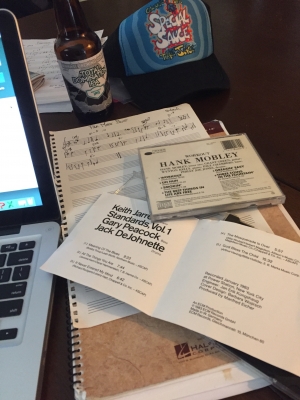Blog
Back >Jazz Nerdings
June 25, 2019
I’ve been doing a bunch of jazz recordings recently.
I really enjoy mixing them afterwords and checking out what the different microphones sound like. I have six channels available, and while most of the time it’s pretty straight forward, there are challenges, like getting the drums right with the allotted two channels. Most of the artistry - of recording anyway, is realizing how different microphones “hear.” Hint, none can do it like our amazing brains!
Anyway, after our session yesterday, I was of course pontificating on my process, comparing mine to pioneering and reference jazz recordings. Indeed, the mythical engineer of the genre is Rudy Van Gelder, who was, I think, somewhat visionary in his use of “close mic’ing.” That is, having one or more microphones for each instrument. In those days days, the sessions were recorded on two tracks only, for stereo. So with multiple signals for the instruments, the engineer electronically makes a mix, an adjustment of the level and tone of each microphone, perhaps adding a synthetic if acoustic reverberation or ambience. (Earlier recordings were often ‘mixed’ by asking the musicians to move closer or further from the one mic.)
So there’s a little - I don’t know if it’s a flaw or a stylization, but on a certain set of recordings, like 1950s & 60s Blue Note Records, you can hear the mix change for the soloists. Check out an album like Hank Mobley’s Workout. On the title track, at the end of the drum solo (right on the form kids, three choruses) at 9:14 you can hear what has to be the microphone for the tenor sax ‘come up’ that is, Rudy turned it on in the mix (probably with a big dial!) as Hank stepped up to the microphone. Check it out, you actually hear more cymbals bouncing around, but then the horn is right there. Dig it on headphones.
At any rate with this technique the recordist ends up ‘performing,’ ostensibly improvising a mix right then with the band. Especially with this music. The engineer needs to follow what’s happening - I’m sure Mr. Van Gelder was quite aware of Philly Joe’s three choruses. In a way, you can hear another interesting ‘player’ on all these records, with subtle - or not so subtle, manipulations of the balance. On this particular recoding Philly Joe is all over every mic in the room - and the change in how, mostly the cymbals, come through to other mics, gives us clues as to how the mix changes through the tune. In later decades, especially for pop recordings, the musicians would be acoustically isolated, either in separate booths or with strategically set baffles, in some regards to manage this phenomena.
In the 1970s with more prevalence of multi-track recording, this became a two (or more) step process, and the performance of the mix, and any other manipulations, could happen afterwords. But as this segmentation of the studio process became more prevalent in pop music, jazz developed another aesthetic which I think was based on the same ideals and reasoning as the previous decades, but for the new technology - and a new position of jazz as a formal music, in society.
I’m thinking here of the ECM label with producer Manfred Eicher and engineer Jan Erick Kongshaug. My reference here is Keith Jarrett Standards, Vol. 1. Great record, I’m sure you’ll agree. First off, they’re recording at Power Station the famous NYC studio with a big room and a great sound. I believe when you hear this recording, you you can hear that room, and - though it’s pretty different music from the Hank Mobley, you definitely don’t hear the microphones going up and down. Any mix changes are situated so as to be un-noticeable, and I really don’t think there is much changing in the mixes. (Oh man, dig the last track, God Bless The Child - love that one.)
The psychoacoustic placement of the music is quite different too. It sounds like a concert hall or a church. They apparently used both the EMT plate reverb and the Lexicon (the first digital reverb that sounded any good) both at once.
The Blue Note recordings, by contrast, sound as if they are in your living room, (even though only Van Gelders earliest stuff, notably Mile’s Prestige series Coookin’, Steamin’ Relaxin’ etc. were actually recorded in his living room.) But the music is recorded closer, and a bit more personally, it's more about the sound of the instruments than the space, while the Keith Jarrett is like a majestic assemblage in an idealized place.
For my part, I try to use the best of both worlds. Of course, my recordings are made in my actual living room as of late, but I enjoy taking that space as it appears in the more ambient mics, and balancing from that - I was once told that’s an English style, then enhancing with a bit of reverb and or delay. But I generally don’t manipulate the levels in each piece. Actually when making review mixes for the musicians, I generally leave the balance set for the whole session.
Look for some stuff shortly on my Bandcamp from the New Brian Myers Quartet.
Portland, OR. Perfect weather, don’t tell anyone.
